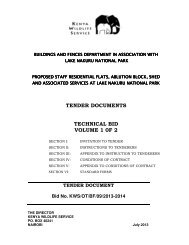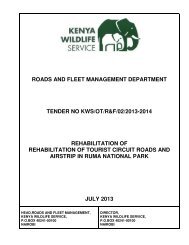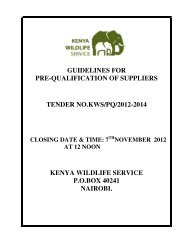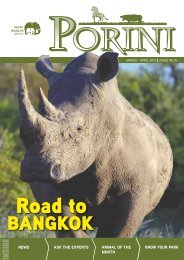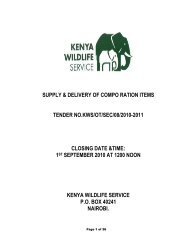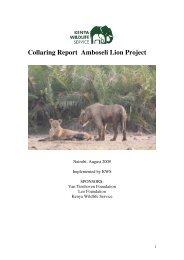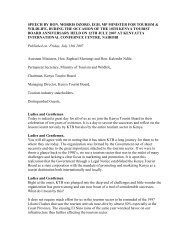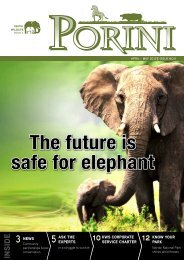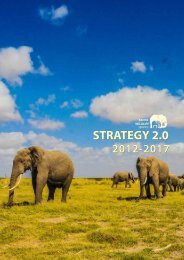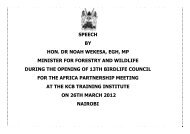Conservation and Management Strategy for the Elephant in Kenya
Conservation and Management Strategy for the Elephant in Kenya
Conservation and Management Strategy for the Elephant in Kenya
Create successful ePaper yourself
Turn your PDF publications into a flip-book with our unique Google optimized e-Paper software.
26 CONSERVATION AND MANAGEMENT STRATEGY FOR THE ELEPHANT IN KENYA<br />
2.1.2.2 Human-<strong>Elephant</strong> Conflict<br />
The rapid human population growth <strong>and</strong> settlement<br />
encroach<strong>in</strong>g on habitat suitable <strong>for</strong> elephants has led to<br />
conflict but equally elephants have sought security which<br />
humanity provides, compound<strong>in</strong>g <strong>the</strong> problem.<br />
The massive decl<strong>in</strong>e of elephants <strong>in</strong> <strong>the</strong> 1970s was a tragedy but<br />
population recovery has co<strong>in</strong>cided with changes <strong>in</strong> l<strong>and</strong> use <strong>and</strong><br />
rapid growth <strong>in</strong> human populations. The modest recovery from<br />
20,000 to ~35,000 animals has brought with it a ris<strong>in</strong>g number of<br />
serious challenges as human <strong>in</strong>jury, deaths <strong>and</strong> crop damage from<br />
elephants rise year on year.<br />
Figure 13 shows human-wildlife conflict hot spots <strong>in</strong> <strong>Kenya</strong>.<br />
The type of conflict commonly experienced <strong>in</strong>clude: human death<br />
<strong>and</strong> <strong>in</strong>jury, crop destruction <strong>and</strong> property damage (Figure 14),<br />
with <strong>the</strong> elephant be<strong>in</strong>g <strong>the</strong> most significant conflict mammal<br />
compared to o<strong>the</strong>rs (Figure 15 <strong>and</strong> 16).<br />
[ FIGURE 15 - ABOVE ] Plate 22.<br />
Protective <strong>and</strong> productive Beehive Fences<br />
- Lucy K<strong>in</strong>g, Save <strong>the</strong> <strong>Elephant</strong>s.<br />
The cause <strong>for</strong> this is complex. Not only has development <strong>and</strong><br />
population growth encroached on suitable elephant habitat, but<br />
<strong>the</strong> improved security, often <strong>in</strong> areas close to human densities, has<br />
encouraged elephants to ga<strong>the</strong>r away from <strong>the</strong> poacher’s gun.<br />
There<strong>for</strong>e, a core objective of <strong>the</strong> new strategy must be to improve<br />
<strong>the</strong> distribution of elephants across its orig<strong>in</strong>al range, <strong>the</strong>reby<br />
reduc<strong>in</strong>g densities <strong>in</strong> human dom<strong>in</strong>ated l<strong>and</strong>scapes <strong>and</strong> restor<strong>in</strong>g<br />
a more natural balance. This is very ambitious but with political<br />
support <strong>and</strong> community buy-<strong>in</strong> this will not only reduce HEC but<br />
will <strong>in</strong>crease opportunities <strong>for</strong> nature based tourism <strong>in</strong> remoter<br />
areas of <strong>Kenya</strong> where <strong>the</strong> poorest of people live <strong>and</strong> can<br />
potentially benefit from <strong>in</strong>creased livelihood opportunities. The<br />
restoration of natural ecological processes of which elephants are<br />
critical will also help to restore rangel<strong>and</strong>s, which have become<br />
encroached, <strong>and</strong> <strong>in</strong> l<strong>and</strong> that has little or no potential <strong>for</strong> crop<br />
agriculture, conserve traditional nomadic peoples, <strong>the</strong>ir livestock<br />
<strong>and</strong> <strong>the</strong>ir culture.<br />
[ FIGURE 13 ] Plate 23.<br />
Mapp<strong>in</strong>g Human Wildlife Conflict Hotspots <strong>in</strong> <strong>Kenya</strong>.<br />
Crop<br />
Destruction<br />
1644<br />
Human Death 72<br />
Human Injury 58<br />
Property<br />
Damage<br />
183<br />
[ FIGURE 14 ]<br />
The elephant is <strong>the</strong> most significant conflict species <strong>in</strong><br />
<strong>Kenya</strong> <strong>and</strong> causes <strong>the</strong> greatest number of conflict cases.<br />
[ FIGURE 16 - ABOVE ] Plate 24.<br />
Chilli based elephant deterrent trials.




